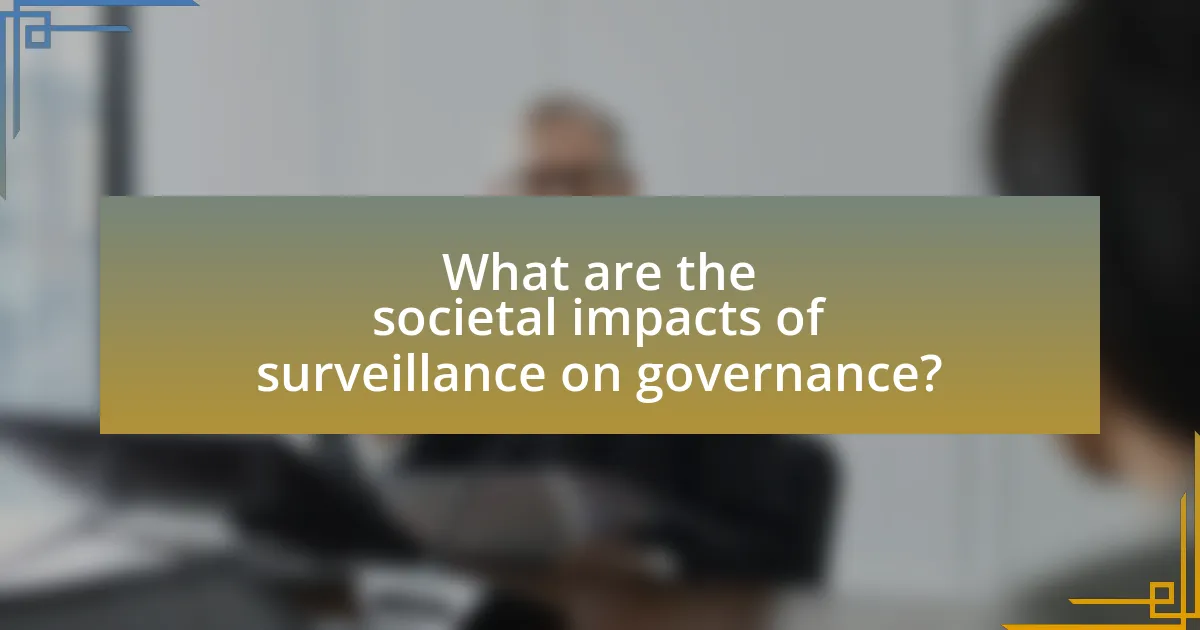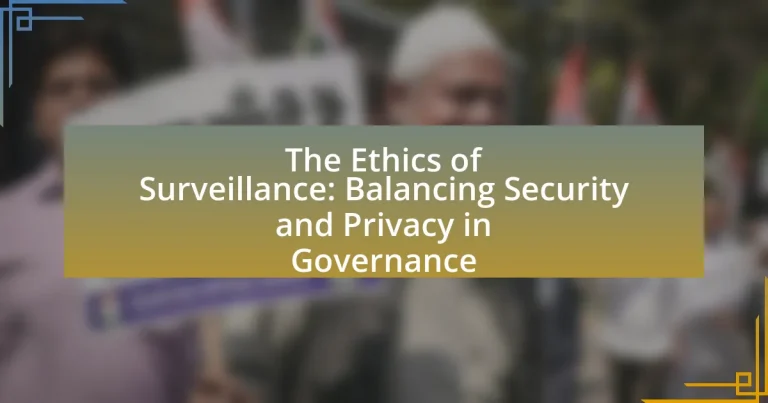The article examines the ethical implications of surveillance in governance, focusing on the conflict between national security and individual privacy rights. It discusses how surveillance practices can lead to abuses of power, erosion of civil liberties, and discrimination against marginalized groups. The article also explores the impact of surveillance on individual behavior, public trust in government, and the legal frameworks designed to protect privacy. Additionally, it highlights the role of technology in surveillance, the societal consequences of monitoring, and best practices for balancing security needs with ethical considerations.

What are the ethical implications of surveillance in governance?
The ethical implications of surveillance in governance primarily revolve around the tension between national security and individual privacy rights. Surveillance practices can lead to potential abuses of power, where governments may infringe upon citizens’ rights without just cause, as evidenced by historical instances such as the NSA’s mass data collection revealed by Edward Snowden in 2013. This breach of privacy raises concerns about the erosion of civil liberties and the potential for discrimination against marginalized groups. Furthermore, the lack of transparency in surveillance operations can undermine public trust in government institutions, as citizens may feel they are constantly monitored without their consent. Ethical governance requires a careful balance, ensuring that surveillance measures are justified, proportionate, and subject to oversight to protect individual freedoms while addressing security needs.
How does surveillance impact individual privacy rights?
Surveillance significantly impacts individual privacy rights by enabling the collection and monitoring of personal information without consent. This intrusion can lead to a chilling effect on free expression and association, as individuals may alter their behavior if they believe they are being watched. For instance, a 2019 study by the Pew Research Center found that 81% of Americans feel that the potential risks of companies collecting their personal data outweigh the benefits. This statistic underscores the widespread concern regarding privacy erosion due to surveillance practices. Furthermore, legal frameworks, such as the Fourth Amendment in the United States, aim to protect against unreasonable searches and seizures, yet advancements in technology often outpace these protections, leading to ongoing debates about the adequacy of privacy rights in the face of increasing surveillance capabilities.
What legal frameworks exist to protect privacy in surveillance practices?
Legal frameworks that protect privacy in surveillance practices include the General Data Protection Regulation (GDPR) in the European Union, which mandates strict guidelines on data collection and processing, ensuring individuals’ rights to privacy. Additionally, the Fourth Amendment of the United States Constitution protects citizens against unreasonable searches and seizures, thereby influencing surveillance practices. The Privacy Act of 1974 in the U.S. also regulates how federal agencies handle personal information, providing individuals with rights to access and amend their data. These frameworks collectively establish legal boundaries for surveillance activities, aiming to balance security needs with individual privacy rights.
How do cultural attitudes towards privacy influence surveillance ethics?
Cultural attitudes towards privacy significantly shape surveillance ethics by determining societal norms regarding acceptable levels of monitoring and data collection. For instance, in cultures that prioritize individualism and personal privacy, such as in many Western countries, there is a strong push for stringent regulations on surveillance practices to protect citizens’ rights. Conversely, in collectivist cultures, where community welfare may take precedence, there may be greater acceptance of surveillance as a means to enhance security and social order. This divergence is evident in the differing legal frameworks; for example, the European Union’s General Data Protection Regulation reflects a high value placed on privacy, while countries like China implement extensive surveillance systems justified by state security and social stability. These cultural perspectives directly influence the ethical frameworks that govern surveillance, leading to varied interpretations of what constitutes ethical surveillance practices across different societies.
What are the arguments for and against surveillance in the name of security?
Arguments for surveillance in the name of security include enhanced public safety and crime prevention. Proponents argue that surveillance technologies, such as CCTV and data monitoring, can deter criminal activity and assist law enforcement in identifying and apprehending suspects. For instance, studies have shown that areas with increased surveillance experience lower crime rates, as potential offenders are aware of the monitoring presence.
Conversely, arguments against surveillance focus on privacy infringement and potential abuse of power. Critics contend that extensive surveillance can lead to a chilling effect on free expression and civil liberties, as individuals may feel constantly watched. Historical examples, such as the misuse of surveillance by government agencies to target political dissidents, underscore the risks of unchecked surveillance practices. Additionally, a 2020 report by the Electronic Frontier Foundation highlights that surveillance disproportionately affects marginalized communities, raising ethical concerns about equity and justice.
How do proponents justify surveillance as a necessary security measure?
Proponents justify surveillance as a necessary security measure by arguing that it enhances public safety and prevents crime. They assert that surveillance technologies, such as CCTV and data monitoring, deter criminal activity and assist law enforcement in identifying and apprehending suspects. For instance, studies have shown that areas with increased surveillance experience a reduction in crime rates; a report by the Home Office in the UK indicated that CCTV reduced crime by 51% in targeted areas. Additionally, proponents claim that surveillance is essential for national security, particularly in preventing terrorism, as evidenced by the use of surveillance in thwarting plots and gathering intelligence.
What are the potential risks of prioritizing security over privacy?
Prioritizing security over privacy can lead to significant risks, including the erosion of civil liberties and the potential for abuse of power by authorities. When security measures are emphasized, individuals may experience increased surveillance, which can result in a chilling effect on free speech and dissent, as people may feel monitored and less willing to express their opinions. Historical examples, such as the NSA’s mass surveillance programs revealed by Edward Snowden, illustrate how prioritizing security can lead to widespread violations of privacy rights, undermining trust in government institutions. Additionally, the lack of privacy protections can create vulnerabilities, as sensitive personal data may be exploited by malicious actors, leading to identity theft and other cybercrimes.
How do different countries approach the ethics of surveillance?
Different countries approach the ethics of surveillance through varying legal frameworks, cultural values, and governmental priorities. For instance, in the United States, surveillance practices are often justified under national security laws, such as the USA PATRIOT Act, which allows extensive monitoring of communications, raising concerns about privacy rights. Conversely, European countries, particularly those in the European Union, adhere to strict data protection regulations like the General Data Protection Regulation (GDPR), which emphasizes individual privacy and requires transparency in surveillance activities. In contrast, countries like China implement surveillance as a means of social control, prioritizing state security over individual privacy, exemplified by the extensive use of facial recognition technology and social credit systems. These differing approaches reflect a balance between security needs and ethical considerations surrounding privacy, influenced by historical, political, and social contexts.
What are the key differences in surveillance laws across various nations?
Surveillance laws vary significantly across nations, primarily in terms of scope, oversight, and privacy protections. For instance, the United States employs the Foreign Intelligence Surveillance Act (FISA), which allows extensive government surveillance with minimal oversight, particularly for foreign intelligence purposes. In contrast, the European Union’s General Data Protection Regulation (GDPR) imposes strict limitations on data collection and mandates explicit consent from individuals, emphasizing privacy rights. Additionally, countries like China implement broad surveillance measures with little regard for individual privacy, often justified by national security concerns. These differences highlight the diverse approaches to balancing security and privacy, influenced by cultural, legal, and political factors in each nation.
How do international human rights standards influence national surveillance policies?
International human rights standards significantly influence national surveillance policies by establishing legal frameworks that protect individual privacy and limit state power. These standards, such as the International Covenant on Civil and Political Rights, mandate that any surveillance must be lawful, necessary, and proportionate to legitimate aims, thereby constraining excessive governmental monitoring. For instance, the European Court of Human Rights has ruled that mass surveillance practices violate the right to privacy, prompting countries to reform their surveillance laws to comply with these rulings. This alignment with international norms ensures that national policies respect fundamental rights while addressing security concerns.

What are the technological aspects of surveillance in governance?
The technological aspects of surveillance in governance include the use of advanced tools such as closed-circuit television (CCTV), drones, biometric systems, and data analytics software. These technologies enable governments to monitor public spaces, track individuals, and analyze large datasets for security purposes. For instance, CCTV systems are widely deployed in urban areas to deter crime and assist law enforcement, while drones provide aerial surveillance capabilities that enhance situational awareness during emergencies. Biometric systems, such as facial recognition, facilitate identity verification and access control, raising concerns about privacy and civil liberties. Data analytics software processes vast amounts of information from various sources, allowing for predictive policing and resource allocation. These technological advancements illustrate the complex interplay between enhancing security and protecting individual privacy rights in governance.
How do surveillance technologies function in modern governance?
Surveillance technologies function in modern governance by enabling the monitoring and analysis of citizen behavior to enhance security and public safety. These technologies, such as closed-circuit television (CCTV), facial recognition systems, and data analytics, allow governments to collect real-time information on individuals and groups, facilitating crime prevention and response. For instance, a study by the Urban Institute found that cities employing advanced surveillance systems reported a significant decrease in crime rates, demonstrating the effectiveness of these technologies in maintaining public order. Additionally, the integration of big data analytics allows for the identification of patterns and trends, further informing policy decisions and resource allocation.
What types of surveillance technologies are commonly used by governments?
Governments commonly use various surveillance technologies, including closed-circuit television (CCTV), drones, biometric systems, and data mining software. CCTV systems are widely deployed in public spaces for monitoring and crime prevention, with millions of cameras installed globally. Drones are utilized for aerial surveillance, providing real-time data and imagery for security operations. Biometric systems, such as fingerprint and facial recognition technologies, are employed for identity verification and access control, enhancing security measures. Data mining software analyzes vast amounts of data from various sources, including social media and communication networks, to identify potential threats. These technologies are integral to modern surveillance practices, reflecting the ongoing balance between security needs and privacy concerns.
How do advancements in technology affect the scope of surveillance?
Advancements in technology significantly expand the scope of surveillance by enabling more sophisticated data collection and analysis methods. For instance, the proliferation of high-resolution cameras, drones, and facial recognition software allows for real-time monitoring of individuals in public spaces, increasing the ability of governments and organizations to track movements and behaviors. According to a report by the Electronic Frontier Foundation, the use of artificial intelligence in surveillance systems enhances the capability to analyze vast amounts of data quickly, leading to more effective identification of potential threats. Additionally, the rise of the Internet of Things (IoT) devices contributes to surveillance by collecting personal data from everyday objects, further broadening the reach of monitoring efforts. These technological advancements raise ethical concerns regarding privacy and the potential for abuse, necessitating a careful balance between security measures and individual rights.
What role does data collection play in surveillance practices?
Data collection is fundamental to surveillance practices as it enables the monitoring and analysis of individuals’ behaviors and activities. By gathering data through various means such as cameras, online tracking, and biometric systems, authorities can identify patterns, assess risks, and make informed decisions regarding security measures. For instance, the use of data analytics in law enforcement has been shown to enhance crime prevention strategies, as evidenced by studies indicating that predictive policing can reduce crime rates by up to 30% in certain areas. Thus, data collection serves as the backbone of effective surveillance, facilitating both security objectives and the potential for privacy infringements.
How is personal data collected and utilized in surveillance systems?
Personal data is collected in surveillance systems through various means such as video cameras, biometric scanners, and online tracking technologies. These systems utilize data to monitor individuals’ activities, identify patterns, and enhance security measures. For instance, facial recognition technology can analyze video footage to identify individuals in real-time, while data from social media and online interactions can be aggregated to profile behaviors and preferences. The effectiveness of these systems is supported by studies indicating that surveillance can deter crime and improve public safety, as evidenced by a report from the Urban Institute which found that cities with extensive surveillance systems experienced a reduction in certain types of crime.
What are the implications of data breaches in surveillance contexts?
Data breaches in surveillance contexts lead to significant risks to individual privacy and security. When sensitive data collected through surveillance is compromised, it can result in unauthorized access to personal information, which may be exploited for identity theft, harassment, or other malicious activities. For instance, the 2017 Equifax breach exposed the personal information of approximately 147 million individuals, highlighting the potential consequences of data breaches in contexts where surveillance is prevalent. Furthermore, such breaches can erode public trust in governmental and corporate entities responsible for surveillance, as citizens may feel their privacy is not adequately protected. This erosion of trust can lead to increased resistance against surveillance initiatives, complicating efforts to balance security and privacy in governance.
How can technology be used to enhance privacy alongside surveillance?
Technology can enhance privacy alongside surveillance by implementing advanced encryption methods and privacy-preserving data analytics. Encryption protects personal data by converting it into a secure format that can only be accessed by authorized users, thereby safeguarding sensitive information from unauthorized surveillance. Privacy-preserving data analytics, such as differential privacy, allows organizations to analyze data trends without exposing individual identities, ensuring that personal information remains confidential even in the context of surveillance. For instance, the use of differential privacy in the U.S. Census Bureau’s data collection has demonstrated how statistical analysis can be conducted while maintaining individual privacy, thus validating the effectiveness of these technologies in balancing security and privacy.
What are some emerging technologies that protect privacy in surveillance?
Emerging technologies that protect privacy in surveillance include differential privacy, homomorphic encryption, and blockchain technology. Differential privacy allows organizations to collect and analyze data while ensuring that individual identities remain confidential, as demonstrated by its use in the U.S. Census Bureau’s data collection methods. Homomorphic encryption enables computations on encrypted data without exposing the underlying information, which is crucial for secure data processing in cloud computing environments. Blockchain technology enhances privacy by providing decentralized and tamper-proof records, allowing users to control their data and access permissions, as seen in various identity management solutions. These technologies collectively contribute to a more privacy-conscious approach in surveillance practices.
How can encryption and anonymization techniques mitigate privacy risks?
Encryption and anonymization techniques mitigate privacy risks by transforming sensitive data into formats that are unreadable or untraceable without the appropriate keys or methods. Encryption secures data by converting it into a coded format, ensuring that only authorized users can access the original information. For instance, the Advanced Encryption Standard (AES) is widely used to protect data in transit and at rest, making unauthorized access significantly more difficult. Anonymization, on the other hand, removes personally identifiable information from datasets, allowing for data analysis without compromising individual privacy. A study by the National Institute of Standards and Technology (NIST) highlights that effective anonymization can reduce the risk of re-identification, thereby enhancing privacy protection. Together, these techniques create a robust framework for safeguarding personal information against unauthorized access and misuse.

What are the societal impacts of surveillance on governance?
Surveillance significantly impacts governance by enhancing state control and potentially undermining civil liberties. Increased surveillance allows governments to monitor citizens more effectively, which can lead to improved security and crime prevention. However, this heightened oversight often results in a chilling effect on free speech and public dissent, as individuals may feel deterred from expressing their opinions or engaging in activism due to fear of being watched. Studies, such as those conducted by the American Civil Liberties Union, indicate that pervasive surveillance can disproportionately affect marginalized communities, leading to systemic discrimination and social inequality. Thus, while surveillance can bolster governance through security measures, it simultaneously poses risks to individual freedoms and societal trust in governmental institutions.
How does surveillance affect public trust in government institutions?
Surveillance negatively affects public trust in government institutions by creating perceptions of overreach and invasion of privacy. When citizens believe that their activities are being monitored without just cause, they may feel that their rights are being violated, leading to skepticism about the government’s intentions. Research conducted by the Pew Research Center in 2019 found that 81% of Americans felt that the potential risks of surveillance by the government outweighed the benefits, indicating a significant distrust in governmental practices. This erosion of trust can result in decreased civic engagement and compliance with laws, as individuals may feel alienated from institutions they perceive as intrusive.
What are the consequences of perceived government overreach in surveillance?
Perceived government overreach in surveillance can lead to significant public distrust in governmental institutions. This distrust often manifests in decreased compliance with laws and regulations, as citizens may feel that their privacy is being violated. According to a 2018 study by the Pew Research Center, 62% of Americans believe that government surveillance programs infringe on their personal privacy, which can result in a lack of cooperation with law enforcement and a decline in civic engagement. Furthermore, such perceptions can fuel social unrest and protests, as seen in various movements advocating for privacy rights and against mass surveillance practices. These consequences highlight the delicate balance between ensuring national security and maintaining public trust in governance.
How can transparency in surveillance practices improve public trust?
Transparency in surveillance practices can significantly improve public trust by fostering accountability and reducing the perception of misuse. When citizens are informed about how surveillance data is collected, used, and protected, they are more likely to feel secure that their privacy is respected. For instance, studies have shown that communities with clear guidelines and oversight regarding surveillance technologies report higher levels of trust in law enforcement. A report by the Urban Institute found that transparency initiatives, such as public disclosures and community engagement, led to a 30% increase in public confidence in police departments that implemented them. This demonstrates that transparency not only reassures the public but also encourages a collaborative relationship between citizens and authorities, ultimately enhancing trust.
What are the implications of surveillance on social behavior and civil liberties?
Surveillance significantly impacts social behavior and civil liberties by fostering a culture of mistrust and self-censorship among individuals. When people are aware of being monitored, they often alter their behavior to avoid scrutiny, leading to a reduction in free expression and open discourse. For instance, a study by the Pew Research Center found that 86% of Americans have taken steps to avoid being tracked online, indicating a direct correlation between surveillance and behavioral changes. Furthermore, surveillance can infringe on civil liberties by enabling government overreach and eroding privacy rights, as seen in cases like the NSA’s mass data collection practices revealed by Edward Snowden, which sparked widespread debate about the balance between national security and individual freedoms.
How does constant surveillance influence individual behavior and freedom of expression?
Constant surveillance significantly influences individual behavior and freedom of expression by fostering self-censorship and altering social interactions. When individuals are aware that they are being monitored, they often modify their behavior to conform to perceived norms or avoid potential repercussions, leading to a reduction in authentic self-expression. Research indicates that environments characterized by high surveillance can create a chilling effect, where individuals refrain from expressing dissenting opinions or engaging in controversial discussions due to fear of scrutiny or backlash. For instance, a study published in the journal “Surveillance & Society” highlights that individuals in heavily surveilled areas are less likely to participate in protests or vocalize dissent, demonstrating how constant monitoring can suppress free speech and limit democratic engagement.
What are the potential effects of surveillance on marginalized communities?
Surveillance can lead to significant negative effects on marginalized communities, including increased discrimination, social stigmatization, and a chilling effect on free expression. Research indicates that heightened surveillance often targets these communities disproportionately, resulting in a loss of trust in law enforcement and public institutions. For example, a study by the American Civil Liberties Union found that surveillance technologies are frequently deployed in neighborhoods with high populations of people of color, exacerbating existing inequalities and fostering an environment of fear. Additionally, the constant monitoring can deter individuals from participating in community activities or expressing dissent, further marginalizing these groups.
What best practices can be implemented to balance security and privacy?
To balance security and privacy, organizations should implement data minimization, encryption, and regular audits. Data minimization involves collecting only the information necessary for security purposes, thereby reducing the risk of privacy breaches. Encryption protects sensitive data both in transit and at rest, ensuring that unauthorized access is prevented. Regular audits assess compliance with privacy policies and security measures, identifying vulnerabilities and areas for improvement. These practices are supported by regulations such as the General Data Protection Regulation (GDPR), which emphasizes the importance of protecting personal data while allowing for necessary security measures.
How can governments ensure ethical surveillance practices while maintaining security?
Governments can ensure ethical surveillance practices while maintaining security by implementing strict legal frameworks that define the scope and limits of surveillance activities. These frameworks should include clear guidelines on data collection, usage, and retention, ensuring that surveillance is conducted transparently and with accountability. For instance, the General Data Protection Regulation (GDPR) in the European Union sets a precedent by requiring organizations to justify their data processing activities, thereby protecting individual privacy rights while allowing for necessary security measures. Additionally, independent oversight bodies can be established to monitor surveillance practices, ensuring compliance with ethical standards and protecting citizens from potential abuses. This approach balances the need for security with the imperative of respecting individual privacy rights.
What role do public consultations play in shaping surveillance policies?
Public consultations play a crucial role in shaping surveillance policies by facilitating public engagement and input in the decision-making process. These consultations allow citizens to express their concerns, preferences, and values regarding surveillance practices, which can influence policymakers to consider the ethical implications of such measures. For instance, studies have shown that when public feedback is incorporated, surveillance policies tend to reflect a balance between security needs and privacy rights, leading to more socially acceptable outcomes. This participatory approach not only enhances transparency but also fosters trust between the government and the public, ultimately resulting in more effective and ethically sound surveillance policies.


